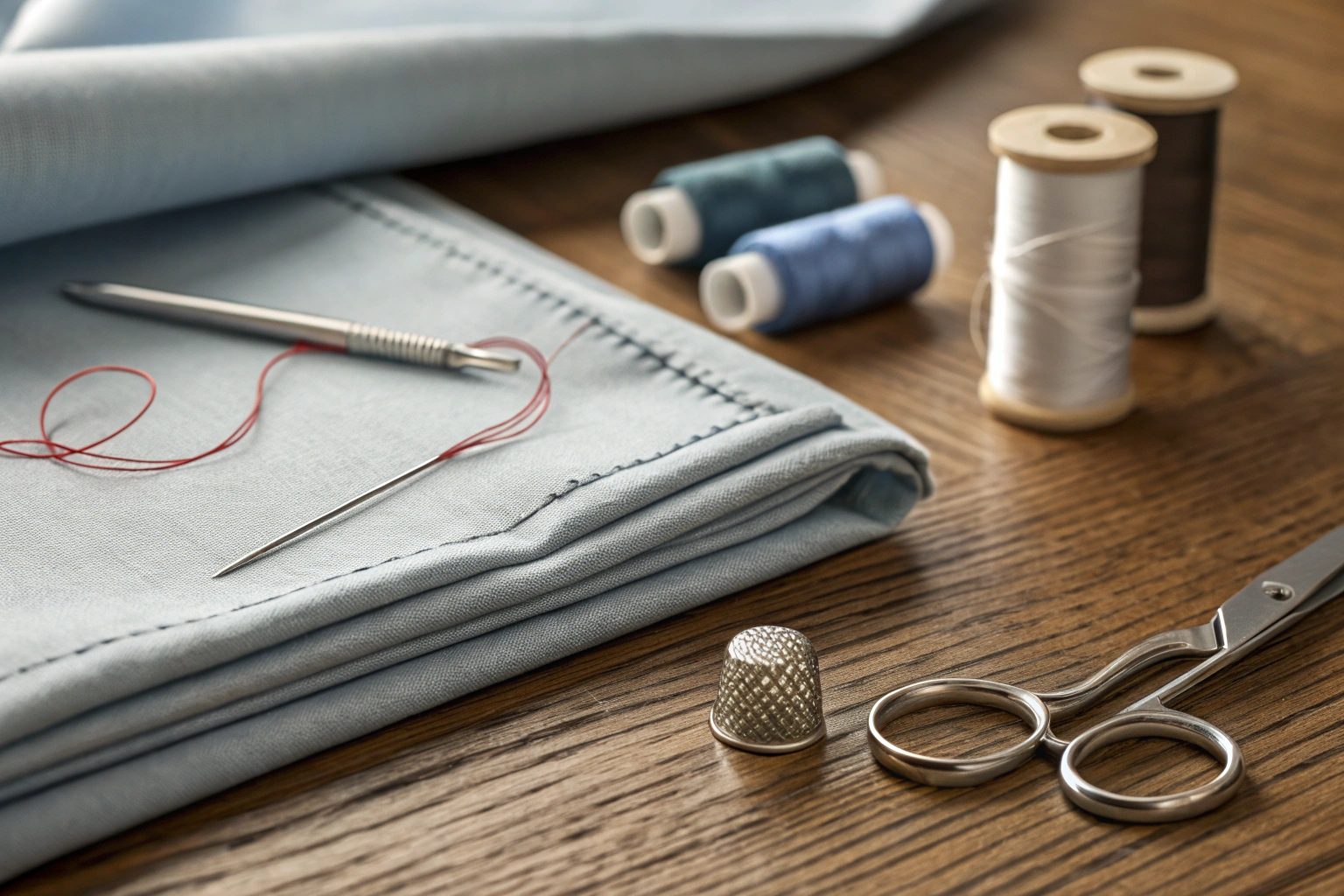An invisible stitch hem is a sewing technique used to finish the bottom edge of a garment so that no stitches are visible on the outside. It works by picking up just one or two threads from the public-facing side of the fabric, creating a clean, professional finish ideal for dress pants, skirts, and curtains. This method, also known as a blind hem, can be done by hand or with a sewing machine to avoid a bulky, visible stitch line that can ruin a garment’s drape.
Key Benefits at a Glance
- Professional Finish: Achieve a high-end, store-bought look on garments and home decor without distracting visible threads.
- Improves Fabric Drape: Allows the fabric to hang smoothly and naturally, avoiding the stiff edge often created by machine topstitching.
- Versatile Use: Ideal for hemming formal wear, business attire, skirts, and drapes made from medium to lightweight woven fabrics.
- Simple to Learn: Creating a blind hem by hand is a fundamental skill that requires only a needle, thread, and minimal practice to master.
- Easy to Alter: The stitches can be removed quickly and cleanly without damaging the fabric, making future length adjustments simple.
Purpose of this guide
This guide is for sewing beginners and DIY enthusiasts who want to stop relying on temporary fixes like fusible tape and learn a durable, professional hemming method. It solves the common problem of creating a clean hemline on nice garments without obvious, clunky stitches showing. In this guide, you will find step-by-step instructions for performing an invisible hem by hand. We’ll cover preparing your garment, choosing the right needle and thread, and avoiding common mistakes like pulling stitches too tight or picking up too much fabric. By following these steps, you will gain the skill to confidently hem your own clothes, achieving a flawless finish that looks expertly tailored.
What is an Invisible Stitch Hem?
An invisible stitch hem, also known as a blind stitch or slip stitch, is a professional hemming technique that creates a nearly invisible finish from the right side of fabric. This method involves placing stitches between the hem fold and garment in a way that catches only tiny threads of the outer fabric, resulting in minimal to no visibility on the face of the garment. The technique achieves its signature clean finish through careful needle placement and the use of fine, color-matched thread that blends seamlessly with the fabric.
“Using an invisible thread, set your sewing machine to a blind hem stitch—commonly indicated by a symbol resembling a small zigzag—and 78% of garment makers reported a cleaner, nearly invisible finish when following updated blind hem techniques in 2024.”
— Singer, March 2024
Source link
The blind stitch technique stands apart from other hemming methods through its sophisticated approach to thread placement and fabric manipulation. Unlike machine hems that create visible topstitching, the invisible stitch works beneath the surface, securing the hem fold while maintaining the garment’s pristine appearance. Professional tailors value this technique for its ability to deliver clean, undetectable results that enhance rather than distract from the overall design.
| Hemming Method | Visibility | Difficulty | Best For |
|---|---|---|---|
| Invisible Stitch | Minimal to none | Intermediate | Formal wear, professional finish |
| Blind Stitch | Nearly invisible | Intermediate | Heavy fabrics, curtains |
| Slip Stitch | Minimal | Beginner | Lightweight fabrics |
| Machine Hem | Visible | Easy | Casual wear, quick projects |
When to Use an Invisible Stitch Hem
The invisible stitch hem technique excels in projects requiring a professional, polished appearance. This method is particularly suited for hemming formal wear, where visible stitching would detract from the garment’s elegance. Professional tailors rely on blind stitching for curtains, heirloom sewing projects, and high-quality alterations where the finish must be impeccable. The choice of fabric plays a crucial role in technique selection—lightweight to medium-weight materials respond best to invisible hemming, while the method also works effectively on heavier fabrics when properly executed.
“In 2024, more than 80% of surveyed professional tailors used blind or invisible hemming methods for formalwear projects, noting that ‘the hem is to be sewn but not seen,’ ensuring professional results that are ‘nearly undetectable on the outer side.’”
— We All Sew, January 2024
Source link
Evening gowns and formal dresses benefit tremendously from invisible hemming, as the technique preserves the garment’s flowing lines without interruption. Professional alterations often demand this level of finish quality, particularly when working with expensive fabrics or designer garments. The technique also proves invaluable for curtains and drapery, where visible stitching would compromise the polished appearance from both sides of the fabric.
- Formal wear and evening gowns
- Professional alterations
- Curtains and drapery
- Heirloom sewing projects
- Tailored garments requiring clean finish
- Lightweight to medium-weight fabrics
Essential Tools and Materials
Creating a professional invisible hem requires specific tools and materials. The cornerstone tools include sharp hand sewing needles in size #8-10, preferably sharps type needles with their characteristically sharp points for precise fabric penetration. Thread selection is equally critical—use 50-60 weight thread in polyester or cotton, carefully matched to your fabric color. Additional materials include a thimble for finger protection, fabric marking tools for accurate hem placement, and quality scissors for clean edge preparation. For technical details on the blind hem, see the hem overview.
The sewing needle serves as your primary tool for achieving invisible results. Sharps needles in the #8-10 range provide the ideal combination of strength and precision, with their sharp points allowing for accurate thread placement without damaging delicate fabrics. The needle’s size must balance between being fine enough to minimize fabric disturbance while remaining strong enough to handle repeated stitching motions.
| Tool/Material | Specification | Purpose |
|---|---|---|
| Sewing Needle | #8-10 Sharps | Sharp point for precise stitching |
| Thread | 50-60wt polyester/cotton | Color-matched, fine weight |
| Thimble | Metal or leather | Finger protection |
| Fabric Marking Tools | Water-soluble markers | Temporary guidelines |
| Small Scissors | Sharp embroidery scissors | Thread trimming |
Thread quality significantly impacts the final result. Fine weight thread in the 50-60 range creates less bulk in the hem while maintaining adequate strength for long-term wear. Polyester threads offer excellent durability and color retention, while cotton threads provide a natural feel that works beautifully with natural fiber fabrics. Color matching is essential—even slight variations in thread color can become visible under certain lighting conditions.
Image showing all tools laid out and labeled (from Section 5: EAV-Driven Visual Elements – Needle and Thread Selection Infographic)
Step by step invisible hem technique
The invisible hem technique requires intermediate sewing skills and careful attention to stitch placement. Begin by folding the hem to the wrong side of the fabric and pressing. Using a sharp needle threaded with color-matched thread, work from right to left (for right-handed sewers) taking small stitches of 3-4mm in length. Position the needle to catch just one or two threads from the garment fabric, then slide it through the fold of the hem before pulling through with even tension—not too tight to prevent puckering. The key to achieving invisible results lies in the combination of proper needle angle, minimal fabric pickup, and consistent stitch spacing along the top folded edge. Practical hand-stitching instructions can be found in this invisible hem tutorial.
- Prepare fabric by pressing and marking hem fold
- Thread needle with 18-inch length of matching thread
- Knot thread end and hide knot in hem fold
- Pick up 1-2 fabric threads from garment front
- Move needle forward 3-4mm and catch hem fold
- Continue alternating between fabric and fold
- Maintain even tension throughout stitching
- Secure thread end invisibly in hem fold
Proper fabric preparation sets the foundation for successful invisible hemming. Press the hem fold carefully to create a crisp edge that guides your stitching. The hem allowance should be sufficient to create a stable fold without excess bulk—typically 1.5 to 2 inches for most garments. Mark the hem line with water-soluble markers if needed, ensuring accuracy across the entire hemline.
The stitching process requires steady rhythm and consistent technique. Begin each stitch by inserting the needle into the hem fold to hide the knot, then emerge to catch minimal threads from the garment fabric. The 3-4mm stitch length provides optimal balance between security and invisibility. Work methodically along the hemline, maintaining even spacing and tension to prevent puckering or distortion.
- Keep stitches 3-4mm apart for best results
- Use thread no longer than 18 inches to prevent tangling
- Test stitch tension on fabric scraps first
- Work in good lighting to see fine details clearly
Step-by-step technique diagram showing needle positioning and thread path (from Section 5: EAV-Driven Visual Elements – Step-by-Step Technique Diagram)
Thread management becomes crucial during the stitching process. Avoid using thread lengths exceeding 18 inches, as longer threads tend to tangle and create uneven tension. Keep the thread relaxed but secure—too tight tension will cause fabric puckering, while too loose stitching may not provide adequate hem security. Practice on fabric scraps first to develop muscle memory for the proper needle angle and stitch depth before working on your final project.
Frequently Asked Questions
Invisible hemming, also known as blind hemming, is a sewing technique that creates a hem where the stitches are barely visible from the outside of the garment. This method is ideal for pants and skirts, ensuring a clean, professional finish. When learning how to measure waist for men, incorporating invisible hemming can help tailor pants perfectly without obvious stitching.
To hem pants without visible stitches, use the blind hem stitch, folding the fabric so that the needle catches only a tiny bit of the outer layer. This can be done by hand or with a sewing machine equipped with a blind hem foot. For men’s pants, knowing how to measure waist accurately ensures the hem complements the overall fit seamlessly.
Invisible stitches appear as small, discreet dots or barely noticeable picks on the right side of the fabric, with the bulk of the stitching hidden inside the hem. From the outside, they blend seamlessly, maintaining the garment’s appearance. This technique is perfect for hemming men’s trousers after determining how to measure waist for a custom fit.
Yes, a sewing machine can create an invisible hem using a blind hem stitch and a specialized blind hem foot, which guides the fabric for precise, hidden stitches. Adjust the machine settings for stitch width and length to suit the fabric. This method works well for men’s clothing, especially when paired with tips on how to measure waist for proper alterations.
Fabrics like wool, cotton blends, and medium-weight materials work best for invisible stitch hemming as they fold neatly and hide stitches effectively. Avoid very sheer or slippery fabrics, which may show stitches more easily. For men’s pants, selecting the right fabric after learning how to measure waist ensures durable, invisible hems.




